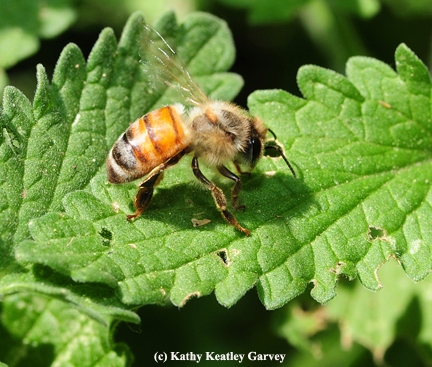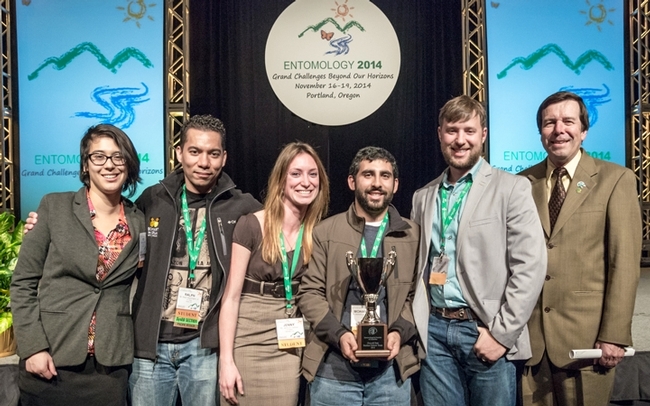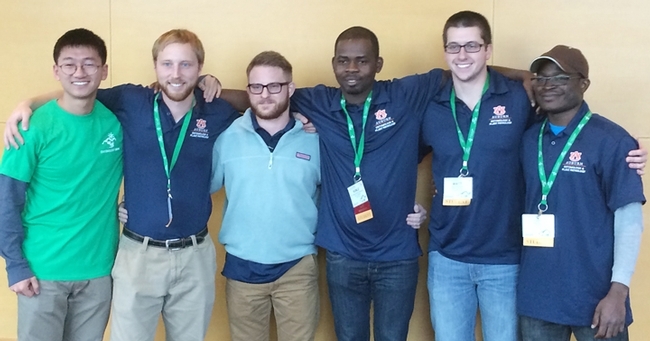
Bee health is a challenge, and this hot topic tied in with ESA President Frank Zalom's theme "Grand Challenges Beyond the Horizons." Zalom, who just completed his presidential term and is now serving as past president, is a distinguished professor of entomology at the University of California, Davis, and an integrated pest management specialist.
Debate topics are always lively and this one was no exception. The teams are given eight months to practice for the 45-minute debate. The end result: their work is published in the ESA journal, American Entomologist.
"Should the agricultural use of neonicotinoids be banned?" Graduate students from the UC Davis Department of Entomology were given the "con" side and Auburn University, Alabama, the "pro side."
From all accounts, it was a fantastic debate, with both sides making key points. The UC Davis team, captained by Mohammad-Amir Aghaee, successfully argued that a ban on the insecticides in agriculture “will not improve pollinator health or restore populations, based on current science. Neonicotinoids are important for control of many significant agricultural and veterinary pests. Part of the solution is to develop better regulations that will protect the health of pollinators and retain the use of an important IPM tool.”
UC Davis won the debate, and then went on to win the overall ESA student debate championship for the second consecutive year.
“Neonicotinoids are important for control of many significant agricultural and veterinary pests,” Aghaee said at the onset. “Part of the solution is to develop better regulations that will protect the health of pollinators and retain the use of an important IPM (integrated pest management) tool.” The team also argued successfully that neonicotinoids (also known as neonics) are not all “created equal.”?? The insecticide, chemically similar to nicotine, is implicated in the mass die-off of pollinators. The European Union recently adopted a proposal to restrict the use of three pesticides belonging to the nenicotinoid family (clothianidin, imidacloprid and thiametoxam) for a period of two years. In addition, the U.S. Fish and Wildlife Service announced that by January 2016, it will ban the use of seeds treated with neonicotinoid pesticides and the use of crops improved through biotechnology throughout the 150 million acres managed by the National Wildlife Refuge System.
In addition to Aghaee, the UC Davis team included graduate students Margaret "Rei" Scampavia, Ralph Washington Jr., and Daniel Klittich. Michael Parrella, professor and chair of the UC Davis Department of Entomology and Nematology, served as their advisor. The Auburn team, captained by Olufemi Ajayi, included Adekunle Adesanya, Julian Golec, Matt Burrows, Scott Clem and alternate Zi Ye. Associate professor David Held served as their advisor.
The protocol included a seven-minute statement by each team; cross-examinations; rebuttals; and questions from the judges and audience.
The UC Davis team cited three main points:
- Pesticides are IMPORTANT tools used in modern agriculture
- Neonicotinoids were registered as reduced risk pesticide to replace the organophosphates, carbamates, and pyrethroids
- Banning neonicotinoids would increase of use of pesticides that have known non-target effects
The UC Davis entomologists agreed that acute and chronic studies "have shown that neonics are toxic to honey bees and bumble bees (Blacquiere et al. 2012)" but argued that “all neonics are not created equal (Brown et al. 2014)." They cited “inconsistent results with field-realistic doses (Cresswell et al. 2012)" and noted that “many other factors have been documented as contributing to pollinator decline (Epstein et al. 2012).”
It's not just insecticides that are killing bees, the UC Davis team pointed out. They listed the varroa mite (Varroa destructor), vectored pathogens, and the acaricides, antibiotics and fungicides that are directly added to the colony. They also mentioned American foulbrood and Nosema bombi; inadequate honey bee nutrition; insufficient food substitute; habitat fragmentation; land-use changes; and the increasing demand for pollination changes.
The UC Davis entomologists recommended that regulatory agencies need more thorough registration guidelines that incorporate bee toxicity data for all pesticides (Hopwood et al. 2012). This would encompass chronic toxicity, sublethal effects and synergistic effects. Another recommendation: mandate better management practices that follow IPM principles that protect bees on crops (Epstein et al. 2012). This would include banning certain application strategies, using less toxic neonicotinoids, and encompass the essential education and communication.
The UC Davis team summarized its argument with “There is NO definitive scientific evidence that neonicotinoids are the primary cause of pollinator declines. Neonicotinoids are important reduced risk pesticides for management of some of our most damaging pests. Neonicotinoids should be better regulated, not banned." They concluded: “Given the current state of knowledge, banning neonicotinoids is a premature and disproportionate response to a complex issue. This requires holistic scientific inquiry and interpretation, and cooperation among stakeholders. Any changes must be based on science rather than opinion, current trends, or fear.”
The Auburn team argued that neonicotinoids are causing the death of bees essential for pollinating our food crops, and that the use of neonicotinoids should end. They outlined six key points:
- Critical time for pollinators in the United States
- Lethal and sub-lethal effects
- Prevalence and exposure
- Effects on other pollinators
- Risk-assessment
- Food Quality and Protection Act (FQPA) as a precedent
Expanding on the fact that this is “a critical time for pollinators in the United States,” the Auburn team pointed out that honey bees pollinate $15-20 billion worth of crops in the U.S., and $200 billion worldwide; that approximately $3 billion worth of crop pollination services are provided by native bees; and that CCD likely has many contributing factors but many of those are enhanced by neonicotinoids. They said that the honey bee population is declining. In 1947, the United States had 6 million bee colonies and today, it's down to 2.5 million.
The Auburn team keyed in on lethal and sublethal effects of neonics: synergistic interactions with other pesticides, including DMI (demethylation inhibitor) fungicides; increased susceptibility to pathogens (Nosema spp.); decrease in foraging success; decrease in overwintering queen survival; learning impairment consequences; and reproductive inhibition. They also called attention to prevalence and exposure to neonicotinoids. They discussed the neonicotinoid residues found on bee-pollinated crops and plants by various means of exposure: seed coating; foliar spray, soil drench, trunk injections; length of residue (soil vs. foliage and length of bee exposure); and single exposures resulting in season-long impacts. They also said the multiple means of exposure due to application can lead to multiple routes of exposure within bees: via pollen, nectar, guttation fluid and extrafloral nectaries.
In their concluding statement, the Auburn team said that current tools for risk assessment may not be adequate; and that limiting neonicotinoid use will not harm agriculture--"it will open the door for more sustainable agriculture and new insecticides." They emphasized that we must save our pollinators, especially in the United States. "The United States is a special case--globally there is an increase in bee colonies; however, the United States is at a critical point at which bee pollination services are being threatened irreversibly."
One of the several swaying arguments that led to UC Davis winning the debate was that not all neonics are created equal, and thus, they should not all be lumped together as "an equal" and all be banned.
The UC Davis team received a $500 cash award, a plaque and a perpetual trophy engraved with UC Davis. ESA president Frank Zalom presented the awards.
Next year's ESA meeting takes place Nov. 15-18 in Minneapolis. Its theme, chosen by ESA President Phil Mulder, professor and head of the Department of Entomology and Plant Pathology at Oklahoma State University, is "Synergy in Science: Partnering for Solutions." He says that the theme "represents a collaborative effort with the other societies, but genuinely keeps us focused on our three strategic principles; 1) our social responsibility to develop ALL members, 2) exploring global partnerships and relationships within our science, and 3) expanding our influence around the world to maximize the impact that entomology has on improving the human condition and our knowledge of the world around us."
Attached Images:

The UC Davis team included (from left) Margaret “Rei” Scampavia, Ralph Washington Jr., Jenny Carlson, captain Mohammad-Amir Aghaee and Danny Klittich. At far right is ESA president Frank Zalom of UC Davis who presented the team with its award. (Photo by Trav Williams of Broken Banjo Photography)

The Auburn University team included (from left) alternate Zi Ye, and members Carl Clem, Julian Golec, Adekunle Adesanya, Matthew Burrows, and Olufemi Ajayi, captain.